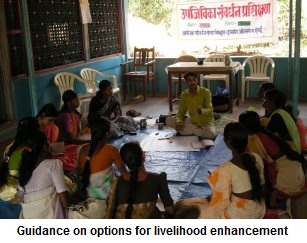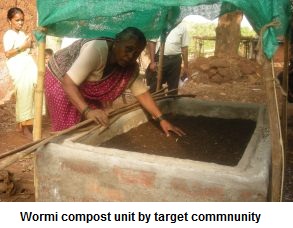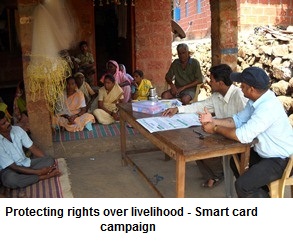Working towards inclusive and sustainable socio-economic
development...
Themes
Techno-Economic Rural Development
Strengthening Citizen Leadership
Natural Resource Management >>
Disaster Risk Reduction & Mitigation
Responce to Climate Change Issues
Themes > Natural Resource Management >
Natural Resource Management >>

The Konkan region in Maharashtra state is a narrow strip of land, bounded by a coastline of around 720 kilometers on to its west, and mountain ranges of 'Western Ghats' on its east. Hence, the region has a fragile ecology comprising of different eco-systems. The majority of the people, especially in the rural areas are dependent 'most of them directly' on the local natural resources for fulfillment of most of their livelihood needs. However, due to various factors, the livelihoods of some of the most marginalized sections in the region have been adversely affected and continue to show signs of decline. The tribal people, small cultivators, and fisher-folk are some of the most marginalized sections in the region, whose livelihoods are insecure and continue to be in jeopardy. Needless to say, women, amongst all such groups are the worst affected, mainly because they bear the major burden of providing livelihoods to their families.
The Core Livelihood Related Issues of the Marginalized Sections
There are three fundamental problems that need to be addressed in the process of improving livelihoods of the marginalized groups. The first problem is lack of access and rights to resources due to various types of violation and denial of access and rights. The second is the declining productivity and increasing cost of inputs of existing livelihood resources and activities and the third is the lack of adequate capabilities necessary to undertake individual as well as collective initiatives to redress rights violation and also adopt new techniques of production and management for improvements in their existing resources and activities.

Hence, in order to enable the marginalized sections to make substantial improvements in their livelihood situation, it is imperative to work on the following three aspects
a. Promoting rights and access to resources
b. Promoting new techniques of production and management, which will decrease costs, and increase productivity, and
c. Enhancing capabilities of the marginalized groups to promote their rights and increase productivity of existing resources and activities
Perspective for Livelihood Enhancement
When we talk about taking efforts for livelihood enhancement of marginalized community through their direct participation in development processes, it becomes essential to secure their present livelihood so that they can have a space to get involved in the activities of livelihood enhancement. If the community is presently struggling to meet the urgent basic needs of their families, their immediate participation in the program is quite unfeasible unless we provide solutions for their present aspirations essential for living.

Another crucial aspect is that the various activities for the economic development of the marginalized community need to be placed in a larger context of promoting secure and sustainable livelihoods. If the activity has to sustain then the income obtained from all these efforts must ultimately lead to satisfaction of primary livelihoods needs. Hence, as the scope of the intervention expands, designing and evaluating it from the livelihoods perspective becomes imperative. Adopting the livelihoods perspective implies looking at not only what households get? But also what they do to satisfy their needs? What resources they have entitlements to, to carry out the necessary livelihood activities? Hence, Parivartan intends to design its interventions in the area of economic development in such a manner that it leads to securing, sustaining, and enhancing natural resources based livelihoods.
Our Experience on Livelihood Enhancement
Parivartan has partnered with Intermon Oxfam for enhancing productivity of livelihood resources. We have worked in the Konkan Livelihood Programme in 2007-08. The major objective was to promote sustainable and productivity enhancing practices in the use and management of natural resources. This objective was significantly achieved through planned activities. The thrust was on accurate understanding of the current status of livelihoods and livelihood resources of the resource-poor families in 16 villages from Khed and Mandangad block, identifying the appropriate livelihood activities to be facilitated and thereafter build technical, social and economic capacities to pursue these livelihood activities. A total of 36 training events were held for beneficiaries in 16 project villages in which 356 beneficiaries participated. The trainings were held on the livelihood activities like improved package of practices for paddy and millet, backyard garden, vegetable cultivation, production of organic manure, poultry and goat rearing. The beneficiaries have been able to undertake these activities effectively with technical inputs from the regular trainings provided.
Protecting Rights over livelihoods
The important livelihood activities of the resource-poor sections in our region are cultivation of land (paddy, millets, pulses, oilseeds, vegetables and other minor crops), animal husbandry (poultry, goat rearing, cattle rearing and dairy on a small scale), fishing (inland, creeks and deep sea), forest collection (timber and non-timber products), its processing and sale, and developing and maintaining fruit-tree orchards. Besides these some of them also engage in wage labour both farm and non-farm activities.
However, several factors (some historical in nature, and some more recent) have severely disturbed this natural resources based livelihoods of the rural people, leading to severe livelihoods insecurity. These disturbances have resulted in high level of migration and low levels of human and social development.
Some of the major factors leading to disturbance/threats to the natural resources based livelihoods of the resource-poor sections, especially from the point of view of denial/violation of rights and /or access to resources are,
> Feudal rural social structure, denial of land rights and failure of land reforms
> Migration due to low level of access to livelihood resources
> Negative impact of rapid industrialization and urbanization on local resources - violation of rights and access, and degradation of resources

On this background, Parivartan has worked with 7 villages in Mandangad block with an objective to organize the communities and develop their capacities around issues related to access and control over livelihood resources and facilitate redresses of individual cases of denial and/or violation of rights and/or access to natural resources. 124 cases were identified out of which 92 cases have been successfully handled.
Citizen Initiative for Livelihood Enhancement
The polluting industries have seriously affected the natural resource based livelihoods in the Lote Industrial Area of Khed block and surrounding area. It is not only the production (both from fishing & agriculture) that had been hampered, but also the market demand has been held back. Hence for getting out of the shadows, the community here required the two pronged strategies. The first strategy was changing the practices & approach to the eco-friendly tunes & another was developing vision for livelihood enhancement utilizing available resources & opportunities.
On this background the local fisher community & Parivartan has opened a new drive, 'Community Initiatives for livelihood Enhancement'. This initiative was comprised a set of activities targeted to meet the gaps & find new livelihood alternatives for the fisher community. Orientation to the new technologies and applications in the fisheries sector formed the base of the activity. Basically two sectors were considered, one is culture activities and another is processing alternatives.
In order to enable this community to make substantial improvements in their livelihood situation, it was imperative to work on the following three aspects (a) promoting rights and access to resources, (b) introducing new livelihood opportunities and (c) enhancing capabilities of the marginalized groups to promote their rights and increase productivity of existing resources and activities.
Giving voice & direction to the silent struggles of communities for securing livelihoods with assured sustainability of natural resources formed the base for the initiative. The idea of livelihood enhancement did not limit itself to improving the financial status of communities, but encompassed community efforts to secure a culture that has been nurtured and prospered by the soil.
Development Tools
'Community Livelihood Manifesto' (CLM)
The 'Community Livelihood Manifesto' (CLM) has been prepared with objective to build the capabilities of the community to get engaged in micro-planning. CLM approach has ensured that the plans & process do not fall prey to populist interests of certain vested-interest groups. The exclusivity of the CLM approach to micro-planning was that the community developed a manifesto, with its own goals & objectives for the planning process & development plans. The CLM ensured the focus on strengthening the local natural resources based livelihoods of deprived sections. The community worked with the local government to translate this manifesto into a plan & then monitored its implementation. In circumstances of negative responses from government authorities, CBOs mobilized the community & agitated struggles to ensure transparent & accountable governance for equitable development.
'Revolving Fund'
To provide sustainable and enhancing natural resource based livelihoods ensuring fulfillment of present basic aspirations, certain hurdles need to be overcome. One of the better option adopted by us is provision of revolving funds for the basic livelihood requirements and for seed capital/initial investment which is a prerequisite for financial assistance from banks and other financial institutions. This has helped to bring forward the pilot individual/group economic projects of livelihood enhancement activities. Utilization of Revolving Fund has made instrumental through groups such as SHGs/fisher folks' co-operatives and People Organizations.